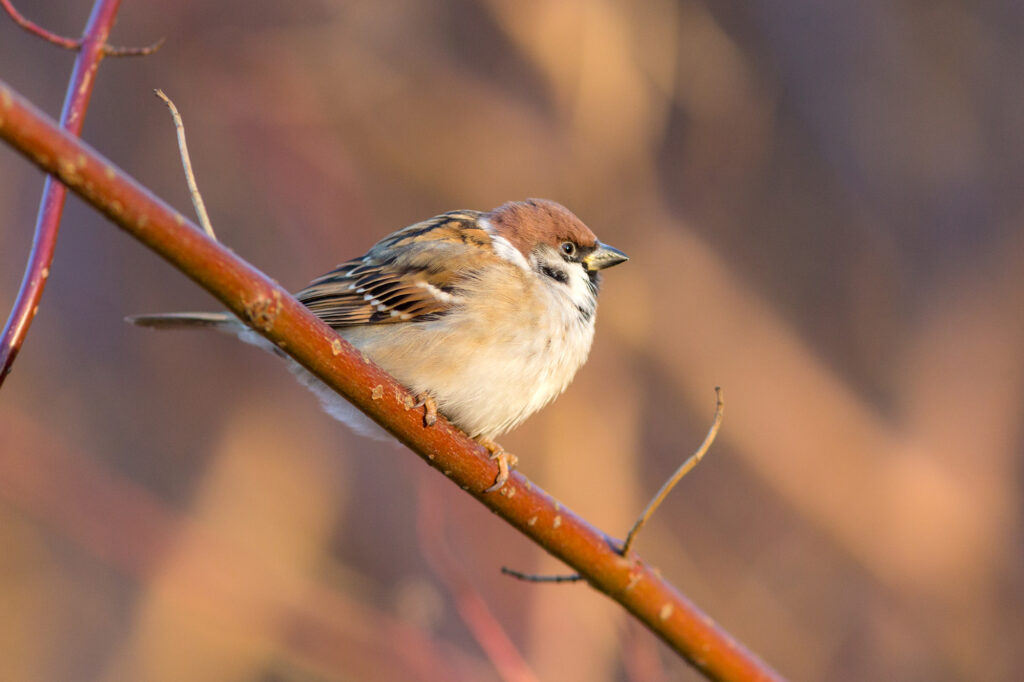From the coastal plains in the east to the towering peaks of the blue ridge mountains in the west, Virginia offers an impressive variety of landscapes to satisfy birds and bird watchers alike.
The sparrow is one of the largest bird tribes that makes Virginia its home. There are 44 sparrow species in North America, and more than 20 of them can be seen in Virginia.
Although some of these sparrow species are quite rare, it can be very rewarding getting to know these ‘little brown jobs’, learning how to identify them, and even how to attract them to your backyard.
We’ll run you through all the species, starting with the most common that you’re certain to spot, and ending with the passing migrants that you might locate if in the right place at the right time!
Eager to learn more? Come on, let’s get to know Virginia’s sparrows!
16 Sparrows in Virginia, Starting With the Most Common
Song Sparrow

- Scientific Name: Melospiza melodia
- Length: 4.7-6.7 in (12-17 cm)
- Weight: 0.4-1.9 oz (12-53 g)
- Wingspan: 7.1-9.4 in (18-24 cm)
According to bird watcher’s reports submitted to ebird.org, song sparrows are the most frequently spotted sparrow in the USA and the most common in Virginia.
The appearance of these medium-sized, streaky sparrows can easily be confused with many other species, but it’s their constant song that, once learned, makes them easy to identify.
Song sparrows are a common sight year-round in Virginia but are most often seen during the winter months. Because the state lies at the southern end of their breeding range, some of them choose to fly further north for nesting.
Song sparrows continue to sing throughout the colder months, and you can get a closer look at them at this time of the year by offering them certain foods. Placing black oil sunflower seeds and other nutritious grains in your bird feeder will increase your chances of seeing these little cuties perched in your yard!
White-throated Sparrow
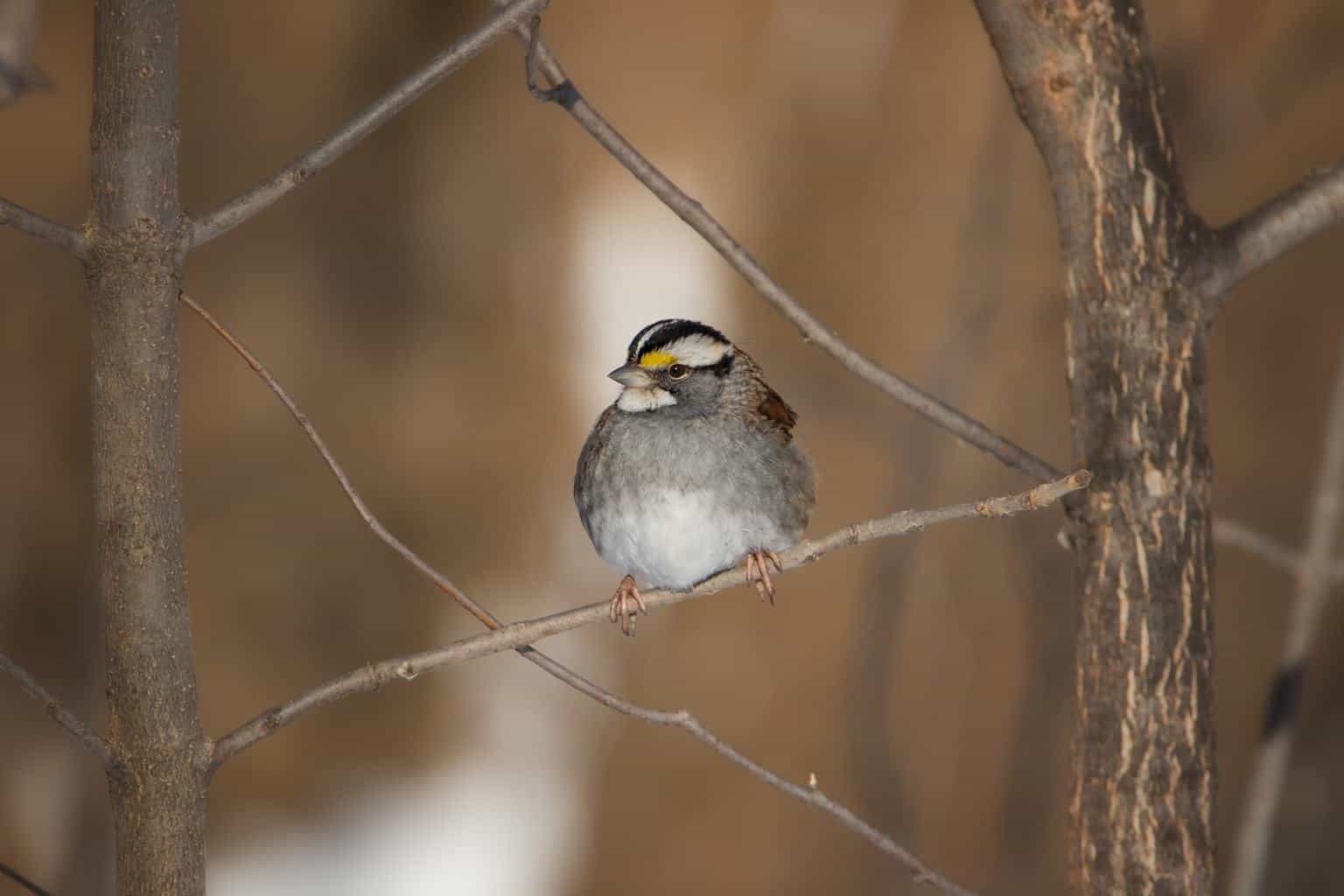
- Species Name: Zonotrichia albicollis
- Length: 6.3-7.1 in (16-18 cm)
- Weight: 0.8-1.1 oz (22-32 g)
- Wingspan: 7.9-9.1 in (20-23 cm)
Coming in at number two, one of the most common species you’ll spot is the white-throated sparrow. Despite only being winter birds in Virginia, they migrate to this state in large abundance, causing them to be spotted quite regularly during colder months.
These medium-sized sparrows have distinctive black and white (or light brown) stripes on the crown of their heads, yellow eyebrows, and light gray-colored chests.
The melancholic whistling ‘Old Sam Peabody (Peabody, Peabody)’ song of this common bird is also very singular and easy to recognize.
This sparrow enjoys flocking during the winter months and will often join mixed flocks with other sparrows. They’re typically seen in mixed woods and hedges but can be tempted to visit backyard feeders as well.
White-throated sparrows are birds that like to move. There are very few places where they can be found year-round, so their seasonal arrival is something to celebrate and savor while they’re around.
Dark-eyed Junco
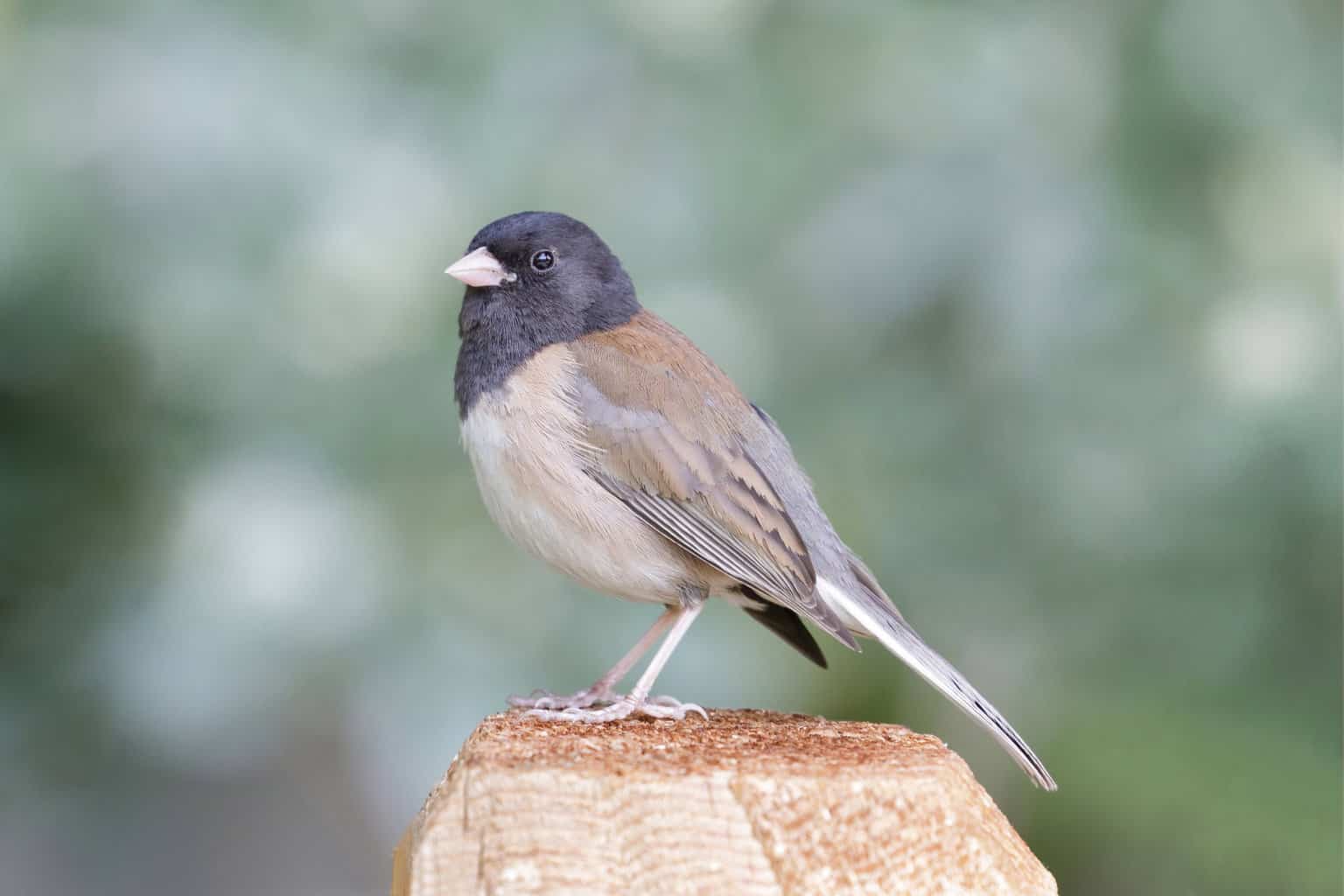
- Species Name: Junco hyemalis
- Length: 5.5-6.3 in (14-16 cm)
- Weight: 0.6-1.1 oz (18-30 g)
- Wingspan: 7.1-9.8 in (18-25 cm)
Sometimes also known as ‘snow birds’, dark-eyed juncos are incredibly hardy sparrows that can be seen in every single state of the mainland continent.
The subspecies of dark-eyed junco you’ll see in Virginia is the aptly-named slate-colored variety. The red-bodied Oregon subspecies is only a very occasional vagrant here.
Male slate-colored dark-eyed juncos have a dark gray upper body, and a white chest, but females can vary from having a slight brown tint to a full-light brown upper body and white undersides.
While they are mainly winter residents in Virginia, small populations of dark-eyed juncos remain to breed in the Blue Ridge mountains during the summer, as well. They’re one of the easiest of all backyard birds to attract to bird feeders during the colder months.
Eastern Towhee

- Scientific Name: Pipilo erythrophthalmus
- Length: 6.8-8.2 in (17.3-20.8 cm)
- Weight: 1.1-1.8 oz (32-52 g)
- Wingspan: 7.9-11.0 in (20-28 cm)
Eastern towhees are a regular sight in Virginia. They’re reported by 25% of bird watchers during the summer months, but smaller numbers also remain in the lowlands of the state during the winter.
These fantastic-looking birds have a black head, wings, and tail, dark, ruby-red eyes, rusty red flanks, and a white belly.
Even though they’re large, colorful, and common sparrows, they can also be fairly secretive. Look out for them scratching about in the undergrowth for nuts, seeds, snails, millipedes, and insects.
Eastern towhees build their nests among fallen leaves and lay up to six eggs. It takes about a month from egg laying until the young fledge the nest – so long as the nest isn’t parasitized by the brown-headed cowbird!
House Sparrow
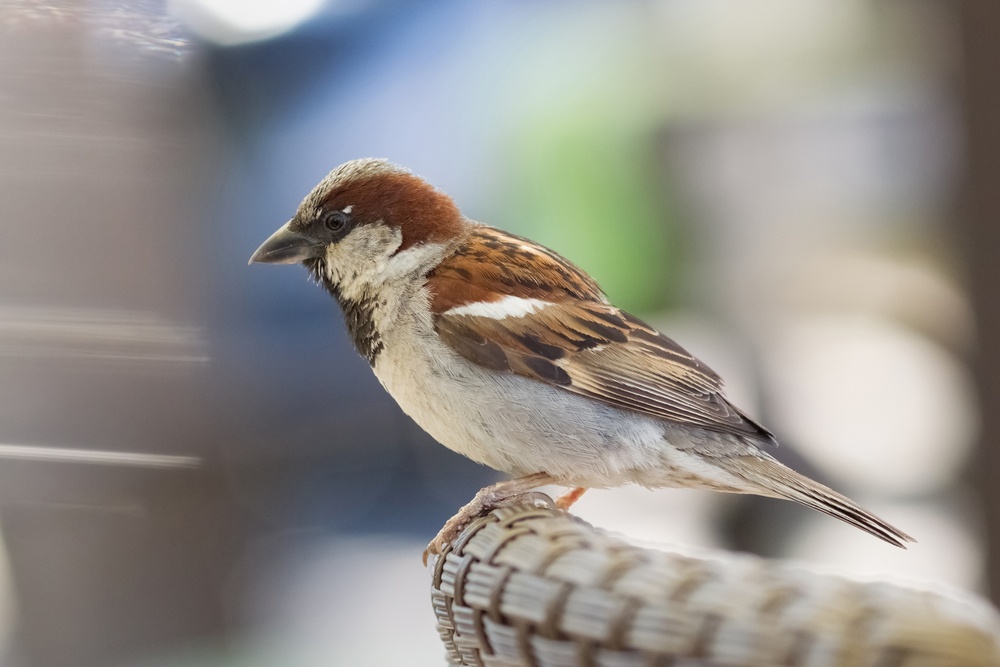
- Scientific Name: Passer domesticus
- Length: 5.9-6.7 in (15-17 cm)
- Weight: 0.9-1.1 oz (27-30 g)
- Wingspan: 7.5-9.8 in (19-25 cm)
House sparrows aren’t native to the US and were introduced to New York City in 1852 from Europe. They quickly spread and can now be found in every single US state, including Hawaii!
Because they’re not related to native sparrows, house sparrows behave quite differently. They don’t migrate and tend to stick to the same territories throughout the year.
Since these assertive birds can sometimes dominate the nesting grounds and birdhouses of other species, some people consider house sparrows a pest and a threat to native birds.
That being said, others find house sparrows to be endearing birds. Their cheerful chirps can brighten up dull winter days, and they can even be trained to eat from your hand!
Chipping Sparrow
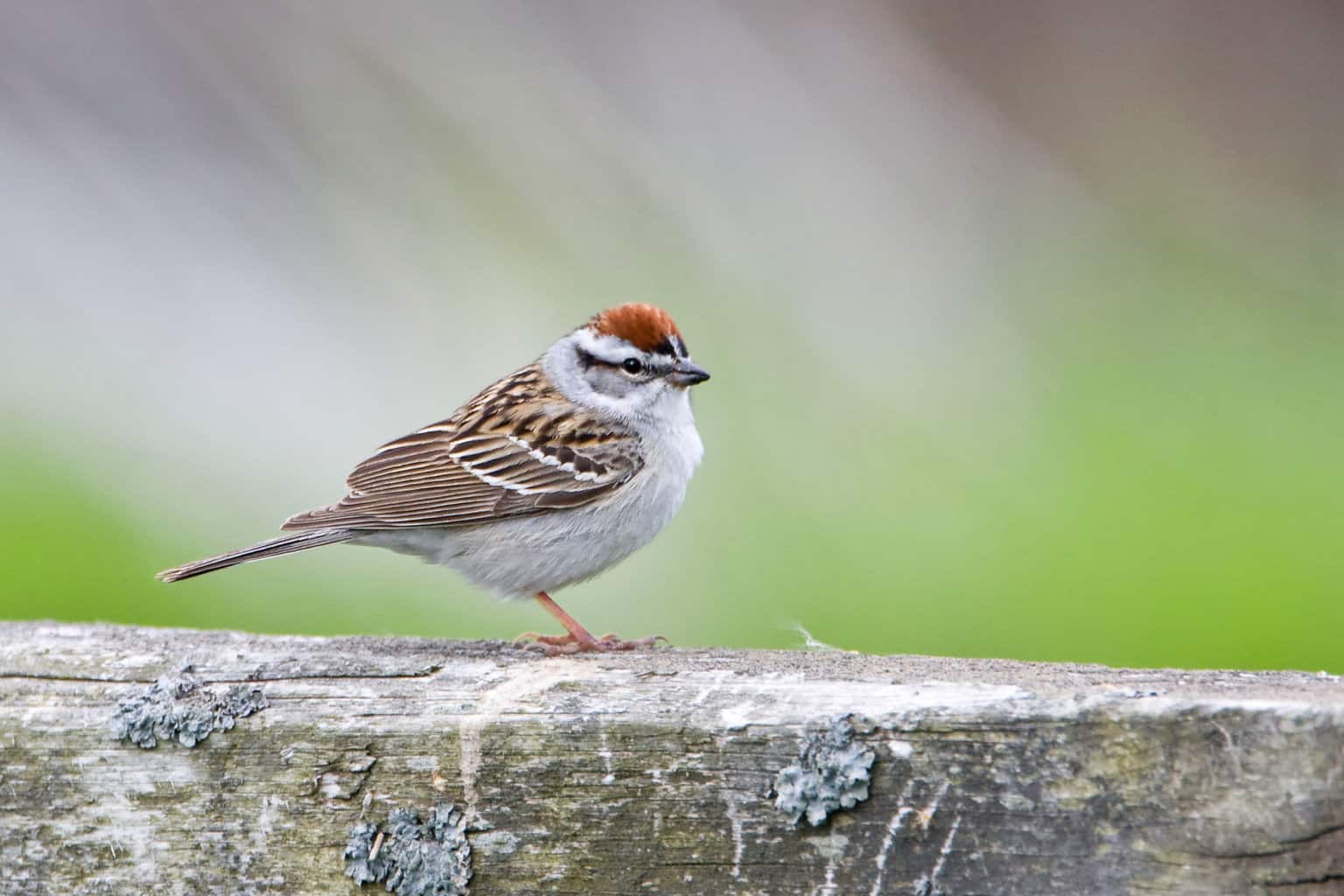
- Scientific Name: Spizella passerina
- Length: 4.7-5.9 in (12-15 cm)
- Weight: 0.4-0.6 oz (11-16 g)
- Wingspan: 8.3 in (21 cm)
Another common and widespread sparrow species, the tiny chipping sparrow was named after its noisy calls.
Learning their vocal repertoire is a great way to locate and identify chipping sparrows, but they can also be recognized by their bright, rusty crown feathers, black eye lines, and gray chests.
Virginia lies at the northern edge of the chipping sparrow’s winter grounds, and they are more commonly seen here during the breeding season than in winter.
They build their nests among shrubs or trees from dried grass and roots, lay up to seven eggs, and can even raise up to three broods per year. No wonder they are so common!
Field Sparrow
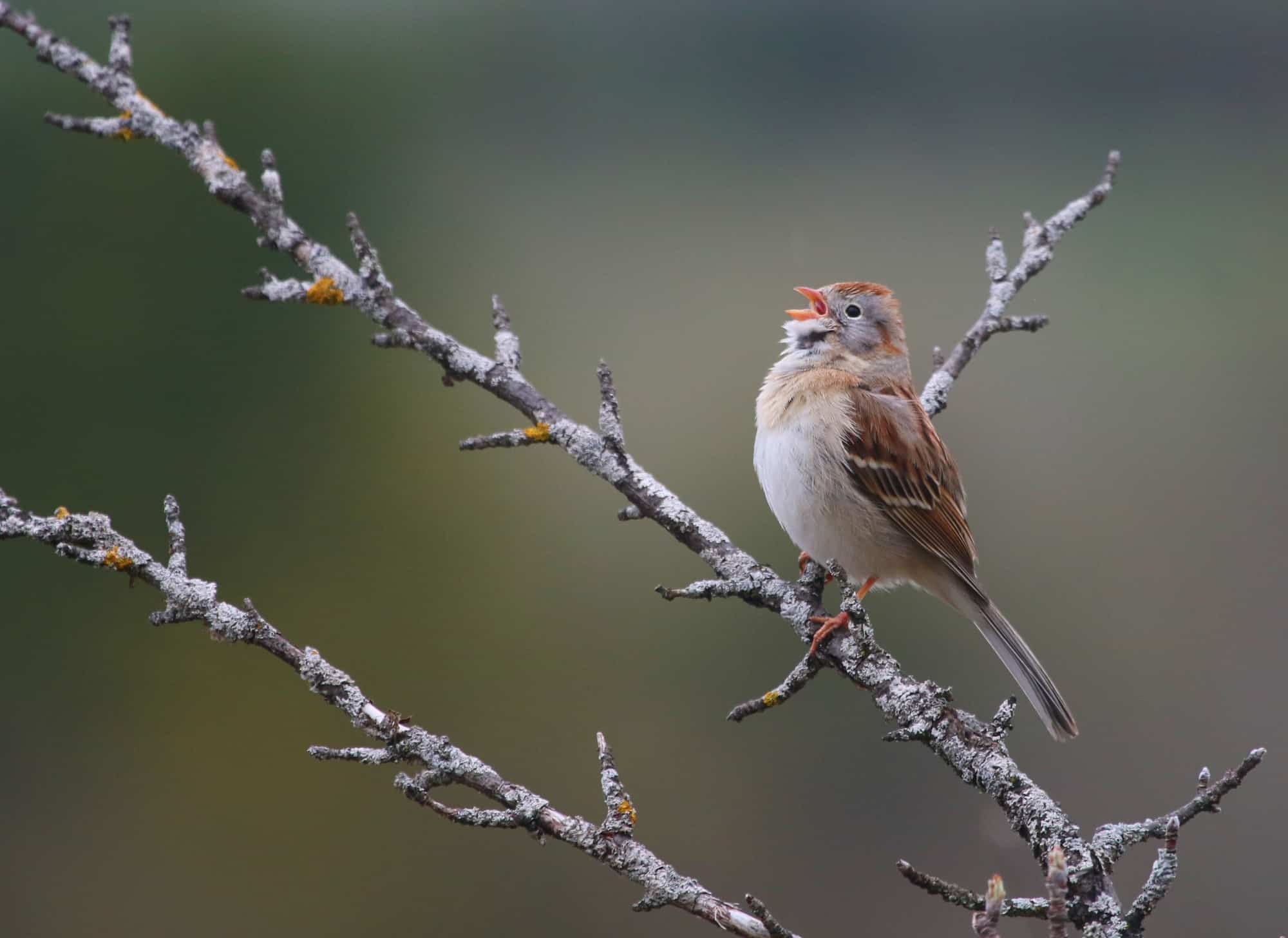
- Scientific Name: Spizella pusilla
- Length: 4.7-5.9 in (12-15 cm)
- Weight: 0.4-0.5 oz (11-15 g)
- Wingspan: 7.9 in (20 cm)
Field sparrows are a close cousin of the chipping sparrow, but are slightly bigger, with a longer tail and a slight orange hue. A good way to identify this shy bird is by its series of high-pitched trills that sound a bit like a bouncing ball coming to a stop!
Field sparrows have a limited geographical range that’s almost exclusively within the Central and Eastern United States. They can be found year-round in Virginia, except in the high Appalachian mountains where they’re only present during the nesting season.
They build their nests on the ground from grass, and as with other ground-nesting birds, their young need to fledge as quickly as possible to avoid predation. For the field sparrow, this “as quick as possible” can mean less than a week!
You can attract adult birds to your backyard feeders in winter by offering them black oil sunflowers, millet, and other tasty treats from a platform feeder.
Swamp Sparrow

- Scientific Name: Melospiza georgiana
- Length: 4.7-5.9 in (12-15 cm)
- Weight: 0.5-0.8 oz (15-23 g)
- Wingspan: 7.1-7.5 in (18-19 cm)
Now we’re moving into the less common sparrows of Virginia. Swamp sparrows only show up on 5% of winter checklists, and are usually absent during the summer months.
In addition to being uncommon, these small, dark, secretive birds can be difficult to spot and identify. The sound of their laughing, high pitch trill of notes, however, is a good way to locate and recognize them.
Since swamp sparrows love water, the best place to spot them is to go looking in wetland or marshy habitats. In winter, they’ll also spend time in the weedy fields.
Swamp sparrows can occasionally be attracted to backyards by offering them a garden pond or bird bath, which makes a great addition to the garden for an array of bird species where they can wash up and drink.
Savannah Sparrow

- Scientific Name: Passerculus sandwichensis
- Length: 4.3-5.9 in (11-15 cm)
- Weight: 0.5-1.0 oz (15-28 g)
- Wingspan: 7.9-8.7 in (20-22 cm)
The browned-streaked savannah sparrow is one of the most common species of open grasslands. You’ll often see them either perched on top of dead weed stems or fences.
Although they resemble song sparrows, they can be differentiated with a pair of binoculars by the yellow wash around their face. Since they don’t visit backyard feeders, it may require a more dedicated effort to observe them.
Savannah sparrows are purely winter birds in most of Virginia, except for the high mountains in the west where they stay to breed. They build their nests on the ground out of grass, and their young take between 1-2 weeks to fledge.
White-crowned Sparrow
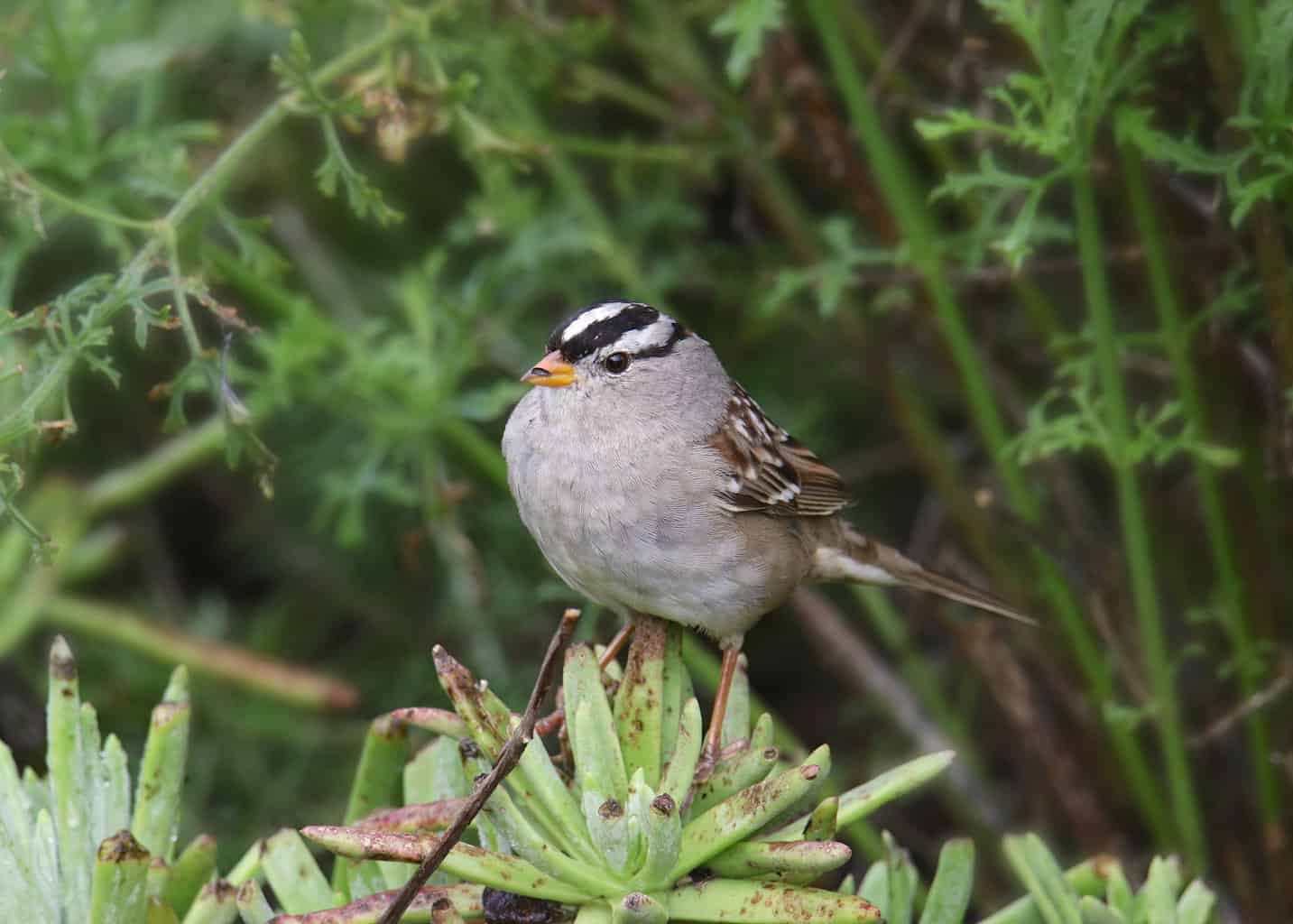
- Scientific Name: Zonotrichia leucophrys
- Length: 5.9-6.3 in (15-16 cm)
- Weight: 0.9-1.0 oz (25-28 g)
- Wingspan: 8.3-9.4 in (21-24 cm)
This variety is a cousin of the white-throated sparrow but is slightly larger and much rarer on the east coast. These birds also lack the yellow eyebrows and white throats of their relatives.
White-crowned sparrows are purely winter visitors in Virginia. You can attract them to your backyard by offering them sunflower seeds, millet, and other types of bird food.
If you’re out in the countryside in Virginia, you may see white-throated sparrows grouped in large flocks, moving over weedy and brushy areas.
While they may also venture onto lawns and open grassy areas at times, they’ll typically dart for cover among weeds when you approach.
Fox Sparrow

- Scientific Name: Passerella iliaca
- Length: 5.9-7.5 in (15-19 cm)
- Weight: 0.9-1.6 oz (26-44 g)
- Wingspan: 10.5-11.4 in (26.7-29 cm)
Fox sparrows are a unique sparrow species that have no immediate relatives. The subspecies that you’ll see in Virginiana is the ‘Taiga’ variety with the classic foxy red feathers.
As one of the largest of all sparrow species, they can appear almost like a small thrush. Their speckled chest and golden bill make them fairly easy to recognize.
The hardy Taiga fox sparrow merely comes to Virginia to enjoy the milder winter climate. For the breeding season, they fly to much colder northerly regions to nest, including the arctic circle!
Although they’re never a common sight in Virginia, you can find fox sparrows scratching about in the undergrowth looking for insects, seeds, and worms during the colder months, much like thrushes.
Grasshopper Sparrow
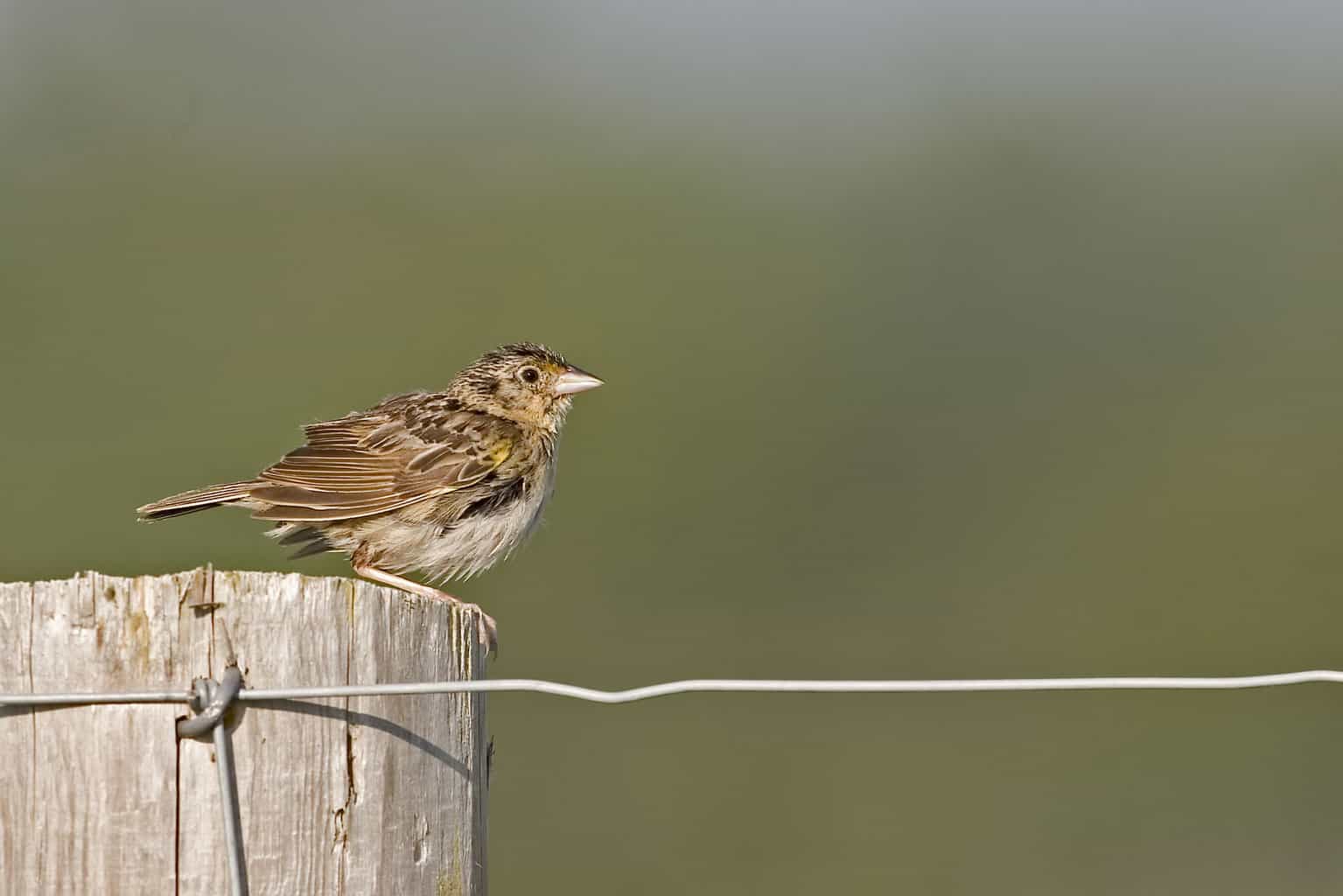
- Species Name: Ammodramus savannarum
- Length: 4.3-4.5 in (10.8-11.5 cm)
- Weight: 0.5-0.7 oz (14-20 g)
- Wingspan: 7.9 in (20 cm)
Grasshopper sparrows are tiny birds of tall, dry, expansive grassland habitats. They aren’t very common these days, and their secretive nature and yellowish camouflage make them difficult to spot.
Sadly, grasshopper sparrow numbers have declined by a massive 70% over the past 50 years, which just goes to show how extensive the damage to native grasslands has been.
These large-headed, large-billed sparrows are purely summer visitors in Virginia and build their nests on the ground from various plant materials. These pretty little structures sometimes feature a roof, crafted by weaving surrounding vegetation together!
Not only do grasshopper sparrows sound like grasshoppers, they love eating jumping insects and feeding them to their young, too!
Seaside Sparrow

- Scientific Name: Ammospiza maritimus
- Length: 5.1-5.9 in
- Weight: 0.7-1.0 oz
- Wingspan: 7.1-7.9 in
Another sparrow with a descriptive name, the seaside sparrow does indeed spend almost all its time near the eastern coastline. They can be seen nearby the sea in Virginia throughout the year.
The long bill and yellow eyebrows of these birds make them relatively easy to recognize, but you need to be in the right place at the right time to see them.
Seaside sparrows love foraging among coastal marshes, and can often be seen feeding in the mud at low tide.
Using their long bill to probe the mud, they live mainly on a diet of seaside invertebrates, but also sometimes eat terrestrial insects, spiders, and their favorite seeds.
American Tree Sparrow
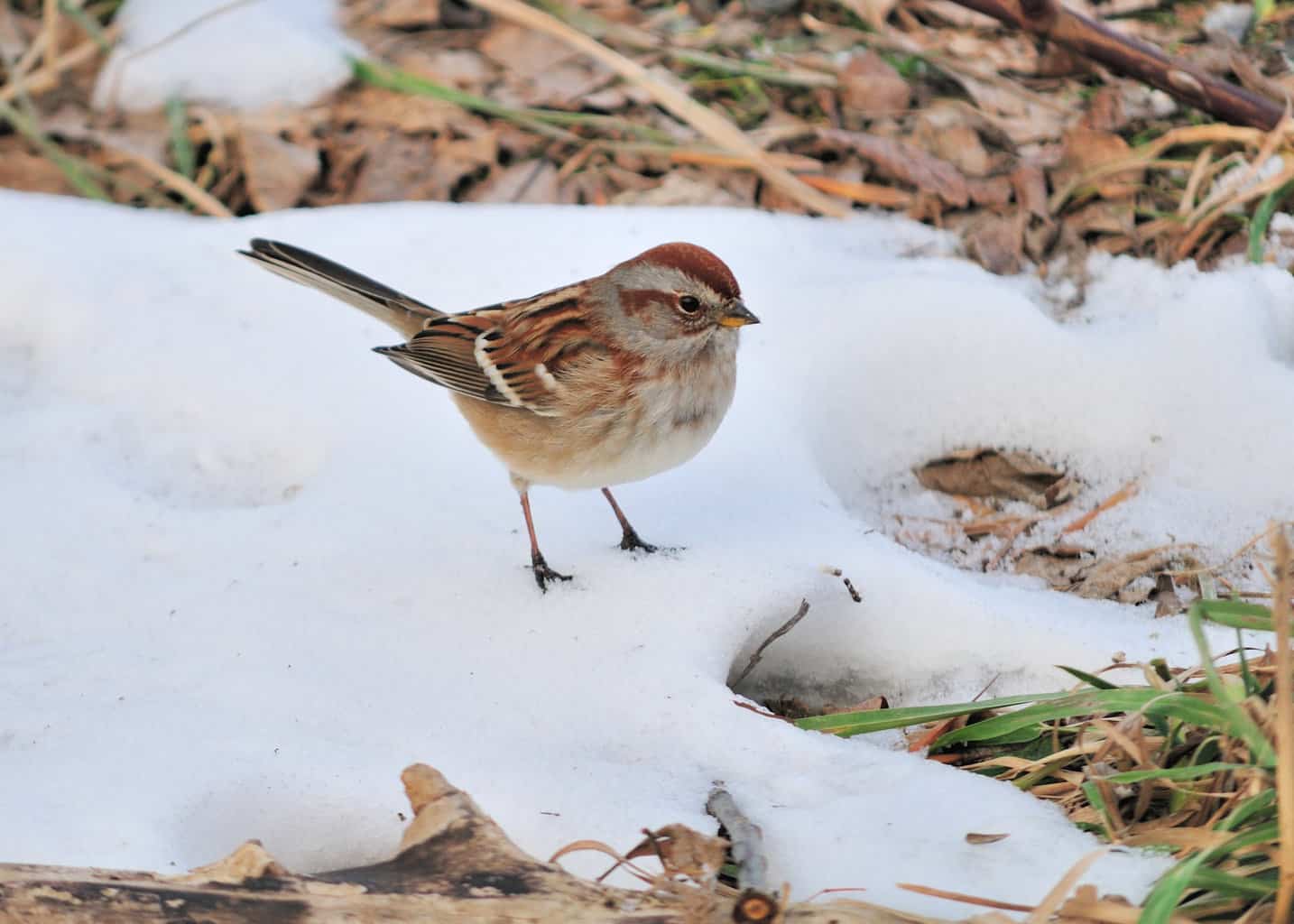
- Scientific Name: Spizelloides arborea
- Length: 5.5 in (14 cm)
- Weight: 0.5-1.0 oz (13-28 g)
- Wingspan: 9.4 in (24 cm)
The American tree sparrow has the most northerly range of all sparrows in North America. Only in the northernmost parts of Virginia can you find these hardy birds in winter – apparently the rest of the state is just too mild for them!
Despite their name, tree sparrows are normally found near the ground. The misnomer about their habitat is due to the early settlers who named this sparrow after their native Eurasian tree sparrows which have a superficial resemblance.
American tree sparrows are best recognized by their rufous crowns and eye lines set against an otherwise gray head and throat. They’re slightly larger than the similar-looking field sparrow.
Nelson’s Sparrow
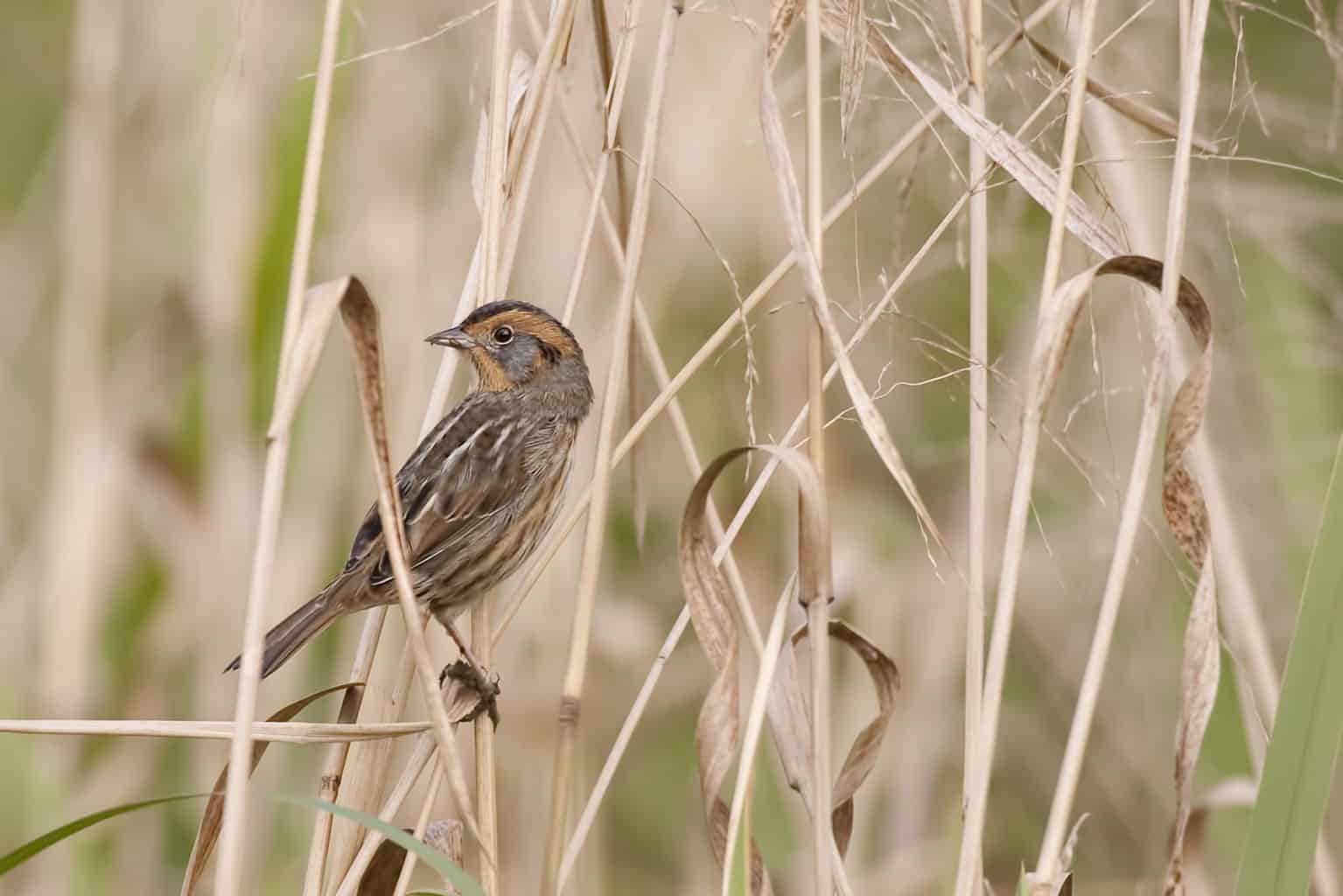
- Scientific Name: Ammospiza nelsoni
- Length: 4.3-5.1 in (11-13 cm)
- Weight: 0.6-0.7 oz (17-21 g)
- Wingspan: 6.5-7.9 in (16.5-20 cm)
Nelson’s sparrow is one of the most recently classified of all sparrow species. That’s because until 1989 they were thought to be the same species as the saltmarsh sparrow!
The two species look almost identical and are very difficult to tell apart during winter when they share the same habitat.
During the breeding season however, Nelson’s sparrows either migrate to the northwest coastline or inland to nest, whereas the saltmarsh sparrow has a more southerly, purely coastal distribution.
Salt Marsh Sparrow

- Scientific Name: Ammospiza caudacuta
- Length: 4.7-5.1 in (12-13 cm)
- Weight: 0.6-0.8 oz (17.1-24.1 g)
- Wingspan: 6.5-7.7 in (16.5-19.5 cm)
Now for Nelson’s sparrow’s look-alike cousin, the salt marsh sparrow! Unlike their more nomadic relatives, the salt marsh sparrow remains in Virginia year-round.
This means if you see these birds in coastal marshes during the summer, you can be sure it’s a salt marsh sparrow rather than Nelson’s.
These two species also share the same habitats as the seaside sparrow but can be told apart from their relatives by the lack of a yellow eyebrow and the orange feathers on their faces.
Saltmarsh sparrow nests are built by females in salt marshes from local vegetation and are sometimes domed for added protection. The nests are occasionally destroyed by high tides, in which case the birds often attempt a replacement brood.
Sparrows in Virginia During Migration
While all of the above sparrows can be considered resident species in Virginia, there are two sparrows that merely pass through the state on their spring and autumn migration passages.

Lincoln’s sparrow is the more commonly seen of the two and shows up on bird watcher’s reports most frequently during the month of October.
It’s during the spring migration, however, that you’re more likely to hear Lincoln’s sparrow’s soothing song – a delightful series of whistles and trills must be among the sweetest of any songbird in North America.
Vesper sparrows are less frequently seen in Virginia but can be seen passing through on their way to and from their more northerly nesting grounds. They may occasionally overwinter in the southeastern corner of the state.
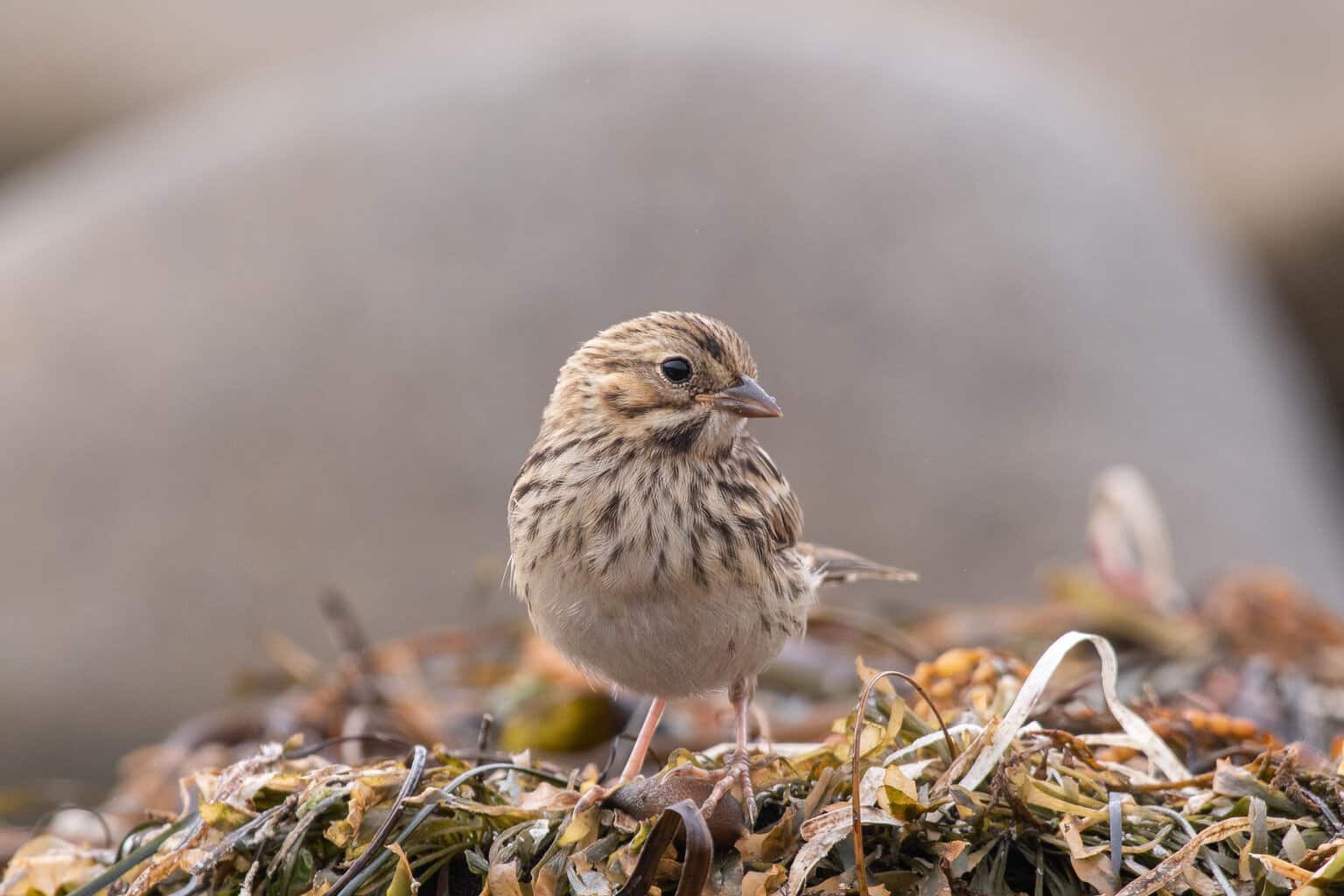
Very Rare Sparrows in Virginia
You’d be very lucky to spot the last few species on our list – there are a few more sparrows that are even rarer in the state.
The aptly named clay-colored sparrow is a very rare winter visitor on the east coast that can sometimes be found here. Although these birds are some of the most numerous in the central plains, they’ll occasionally pop up in almost any territory of North America.
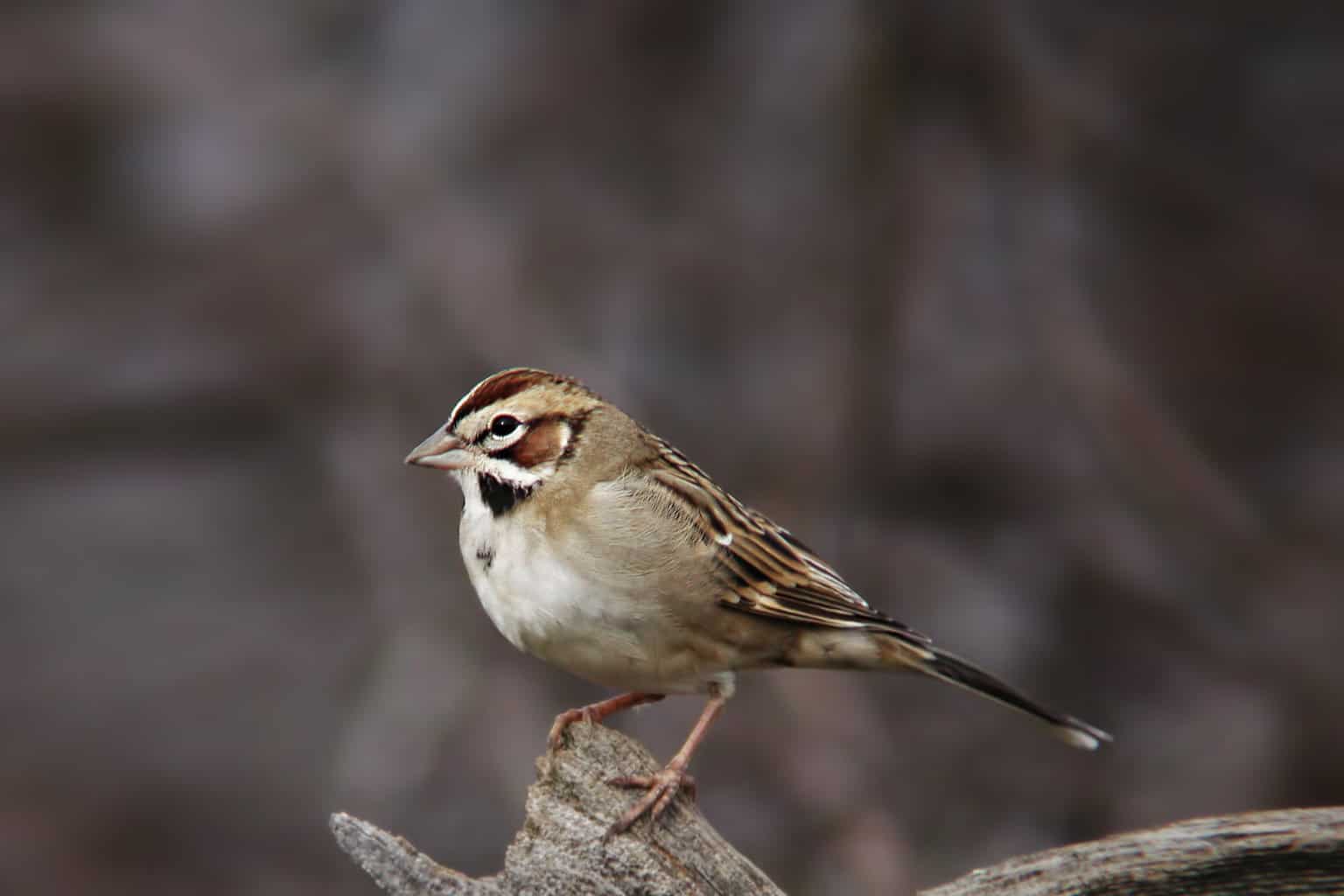
The lark sparrow is another bird that is far from rare but is seen by less than one in a thousand bird watchers this far east.
Lastly, the diminutive LeConte’s sparrow regularly overwinters as far north as South Carolina, but can very occasionally be seen in Virginia during mild winters.
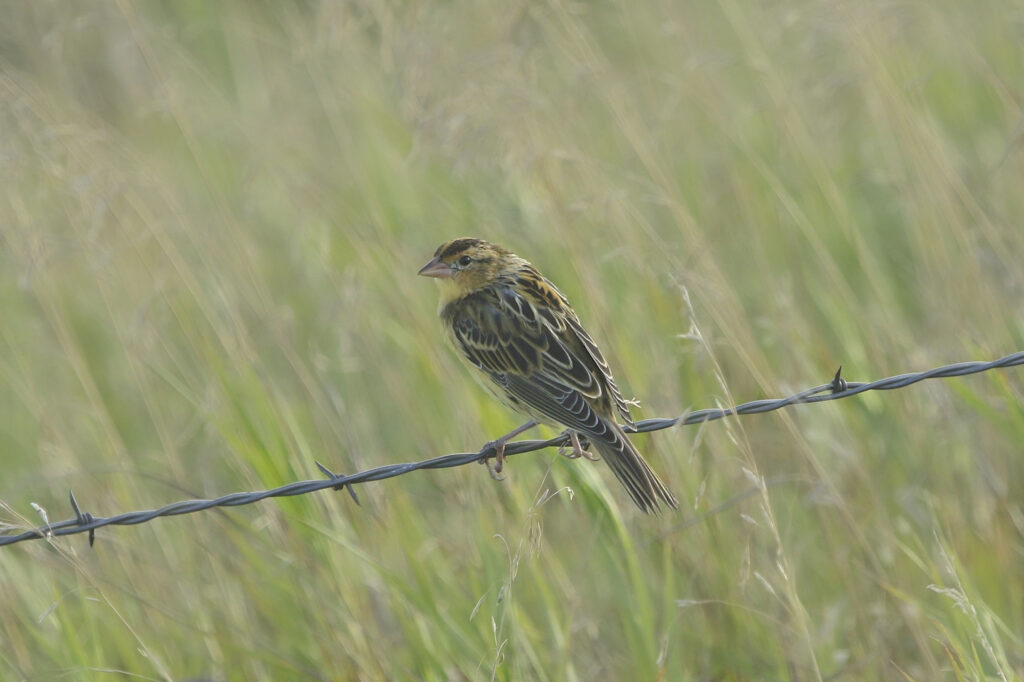
As the climate changes, the distribution of many sparrow species will likely shift further to the north.
Conclusion
There are more than 20 sparrows that can be seen in Virginia. Although several of them are transient or very rare, this still represents impressive diversity for a smaller state.
Besides sparrows, there are too many fascinating bird species in Virginia to mention. That’s why we’ve compiled the most impressive of them in our guide to 30 iconic birds of Virginia, which you can check out at this link!
Happy birding!

